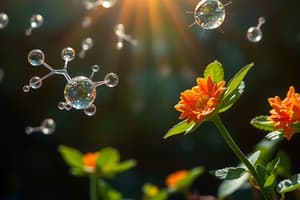Podcast
Questions and Answers
Which of the following elements are necessary for the formation of carbohydrates?
Which of the following elements are necessary for the formation of carbohydrates?
- Carbon, Nitrogen, Oxygen
- Carbon, Hydrogen, Oxygen (correct)
- Carbon, Phosphorus, Sulfur
- Hydrogen, Oxygen, Nitrogen
What distinguishes triglycerides from phospholipids?
What distinguishes triglycerides from phospholipids?
- Triglycerides are found only in plants
- Triglycerides contain no fatty acids
- Phospholipids are solid at room temperature
- Phospholipids contain a phosphate group (correct)
Which biomolecule is primarily responsible for forming plant cell walls?
Which biomolecule is primarily responsible for forming plant cell walls?
- Carbohydrates (correct)
- Proteins
- Nucleic Acids
- Fats
In what ratio are the elements in carbohydrates typically found?
In what ratio are the elements in carbohydrates typically found?
Which of the following statements correctly characterizes lipids?
Which of the following statements correctly characterizes lipids?
Which of these options is an example of a polysaccharide?
Which of these options is an example of a polysaccharide?
What is a trace element?
What is a trace element?
Which of the following best describes a disaccharide?
Which of the following best describes a disaccharide?
Which of these is NOT a major type of biomolecule found in food?
Which of these is NOT a major type of biomolecule found in food?
How do carbohydrates serve a metabolic role in the body?
How do carbohydrates serve a metabolic role in the body?
Which elements are primarily found in proteins?
Which elements are primarily found in proteins?
What is a common metabolic role of proteins?
What is a common metabolic role of proteins?
Which vitamin is associated with the deficiency disorder known as scurvy?
Which vitamin is associated with the deficiency disorder known as scurvy?
Which of the following minerals is essential for making haemoglobin in animals?
Which of the following minerals is essential for making haemoglobin in animals?
What color indicates a positive test for the presence of protein using Biuret reagent?
What color indicates a positive test for the presence of protein using Biuret reagent?
Which food test requires heating to detect the presence of a reducing sugar?
Which food test requires heating to detect the presence of a reducing sugar?
What role does magnesium play in plants?
What role does magnesium play in plants?
What distinctive color change occurs when reducing sugar is present in a test using Benedict's solution?
What distinctive color change occurs when reducing sugar is present in a test using Benedict's solution?
What percentage of cell contents is comprised of water?
What percentage of cell contents is comprised of water?
Which biomolecule can be identified using brown paper?
Which biomolecule can be identified using brown paper?
Flashcards are hidden until you start studying
Study Notes
Nutrients
- Chemical substances in food vital for organisms' functions.
- Necessary for energy production and growth.
Elements in Food
- Six essential elements: Carbon, Hydrogen, Oxygen, Nitrogen, Phosphorus, Sulfur.
Trace Elements
- Elements required in minute quantities, such as Iron.
Biomolecules in Food
- Five major types: Carbohydrates, Lipids, Proteins, Vitamins, and Water.
Carbohydrates
- Composed of Carbon, Hydrogen, Oxygen in the ratio Cx(H2O)y.
- Monosaccharides: Single sugar units (e.g., Glucose).
- Disaccharides: Two sugar units joined (e.g., Sucrose).
- Polysaccharides: Multiple sugar units (e.g., Starch).
- Sources include Bread, Rice, Pasta.
- Structural role: Cellulose forms plant cell walls.
- Metabolic role: Broken down during respiration to release energy.
Lipids
- Contain Carbon, Hydrogen, Oxygen.
- Fats: Solid at room temperature; Oils: Liquid at room temperature.
- Carbohydrates (fixed compositional ratio) differ from lipids (no fixed ratio).
- Basic structure: Triglyceride (glycerol + three fatty acids).
- Phospholipids contain phosphate groups; triglycerides do not.
- Sources: Butter, Oil.
- Structural role: Phospholipids are key components of cell membranes.
- Metabolic role: Provide stored energy.
Proteins
- Composed of Carbon, Hydrogen, Oxygen, Nitrogen; sometimes Phosphorus and Sulfur.
- Composed of amino acids.
- Sources: Milk, Meat.
- Structural role: Keratin found in hair.
- Metabolic role: Enzymes regulate chemical reactions.
Vitamins and Deficiency Disorders
- Water-soluble example: Vitamin C (deficiency: Scurvy).
- Fat-soluble example: Vitamin D (deficiency: Rickets).
Minerals
- For plants: Calcium (strong cell walls), Magnesium (chlorophyll).
- For animals: Calcium (strong bones/teeth), Iron (haemoglobin).
Water
- Key properties: Good solvent, makes up bulk of body fluids.
- Constitutes 70-95% of cell contents.
Qualitative Food Tests
- Biuret reagent: Tests for protein presence; lilac indicates protein.
- Benedict's solution: Tests for reducing sugars.
- Brown paper test: Used for lipids; allowed to dry to confirm lipid presence.
- Heat required for reducing sugar test; positive: brick-red color.
Studying That Suits You
Use AI to generate personalized quizzes and flashcards to suit your learning preferences.




